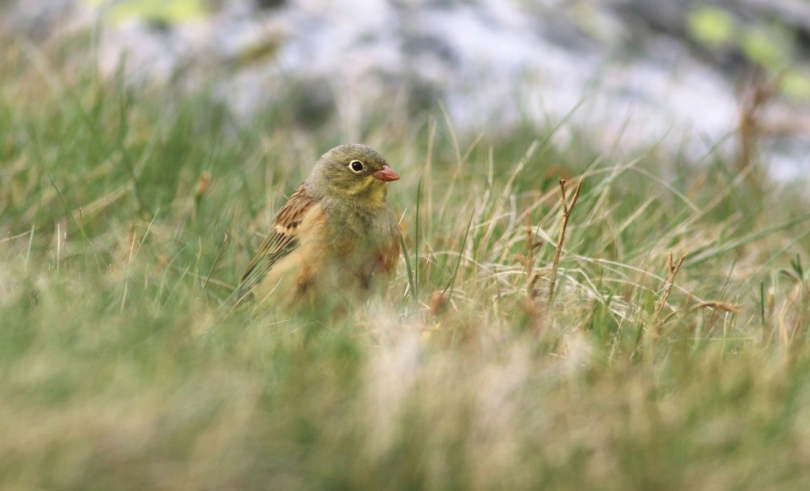It’s peak season for migrating Ortolan Buntings in northwest Europe and in addition to several sightings and ringed birds, several have been recorded by the UK’s fledgling ‘nocmig network’. As well as the now regular locations of Portland/Weymouth and Poole Harbour area, birds have also been recorded (so far) over London, Surrey and Cambridge. They’re being recorded in several locations that don’t have any history of visual records of Ortolans, prompting lots of head-scratching about the likelihood of detecting such species and questions about identification criteria. The Sound Approach have produced two very detailed blog posts on the identification criteria (here and here), describing the common call types and their potential confusion species. With reference to the commonly used plik call they say:
European Goldfinch Carduelis carduelis has a call similar to Ortolan Bunting’s plik, although it normally uses this call in combination with others. Goldfinches usually move around in tight flocks, and we have never recorded one migrating at night, despite it being such a common species…Note the variation in pitch and rhythm, giving a bouncing effect. On odd occasions when a single goldfinch repeats only its most plik-like calls, these are likely to be given in twos as well as singly, and with much shorter gaps than an Ortolan Bunting
The suggestion that Goldfinch calls are a potential confusion for Ortolans has been raised as an issue, particularly in those counties where Ortolan Buntings have never been recorded in the daytime.
Setting aside for a moment how similar the calls are, it is helpful to quantify the potential for confusion from night flight calls of Goldfinches. I checked on the timing and reporting rate of diurnal and nocturnal Goldfinches and Ortolan Buntings on Trektellen. The many thousands of hours of day and night recording submitted there should give a good indication of the behaviour of these species.
Diurnal movements
First, here’s the timing of Goldfinch diurnal autumn migration (all countries, all years), showing a very low level of movement through late summer picking up in late September to a broad peak through October to November.
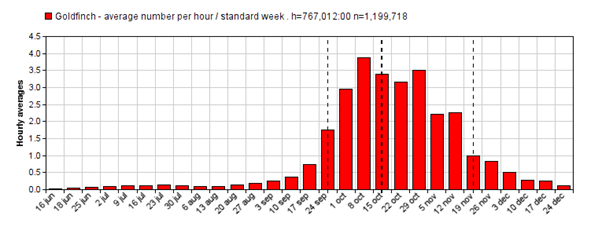
For comparison, here’s the diurnal autumn phenology of Ortolan. Ortolans in daytime are clearly much earlier than Goldfinches and at the time when most Ortolans are moving, Goldfinches movements have barely got started. These results are largely driven by data submitted in the Netherlands, Germany and France where Ortolan passage is well understood.
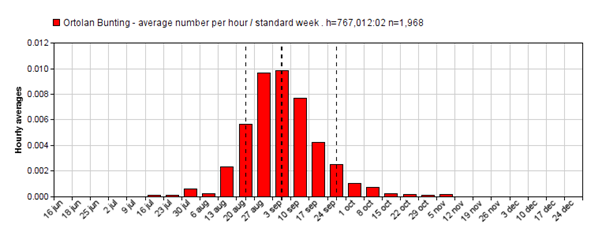
Nocturnal movements
So now looking at the phenology of nocturnal movements of Goldfinch, here’s the corresponding plot.
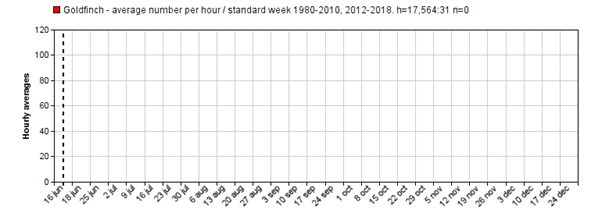
There’s no error in the graph. In 17,564 hours of nocturnal monitoring during autumn, no Goldfinches have been recorded. You might notice in the date range of the graph above that I have omitted 2011. That’s because there is a handful of sound-recorded Goldfinches submitted from Besh Barmag, Azerbaijan by Michael Heiss (note that totals here are currently numbers of calls, not numbers of birds). Michael records from sunset to sunrise, so includes civil twilight which most other nocturnal surveyors don’t consider. The handful of birds he has were all just pre-dawn (e.g. here) and represent the initiation of diurnal movements. More generally within Trektellen there are just two other “nocturnal” Goldfinches, recorded in March 2016 in the Netherlands, though I can’t tell what time of night they were.
For comparison here is the phenology of nocturnal Ortolans, which matches very nicely the timing of Ortolan diurnal migration as expected. Again, much of the data come from the Low Countries where Ortolan calls are well understood.
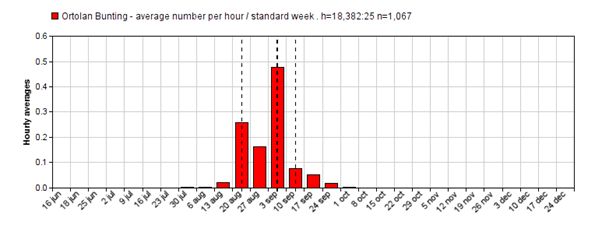
Possible interpretations
There are two ways of looking at these results – that nocturnal Ortolans are all/mostly misidentified Goldfinches, or that the identification of nocturnal Ortolans is all/mostly correct.
To take the view that all (or even some proportion) of the claimed nocturnal Ortolans are actually Goldfinches raises some tricky questions. Why are these nocturnal “Goldfinches” moving about a month or so before diurnal movements. Perhaps they are recently fledged juveniles? But if that is the case, why are they not apparent over a much wider window as juvenile Goldfinches can be around from late June onwards. Why are nocturnal Goldfinches not detected at any other time of year despite being present year-round at these locations. Further, these nocturnal “Goldfinches” would have to be giving only an unusual call and none of their more familiar calls at night. Otherwise in 17,500 hours of recording, nocturnal recorders would be picking them up more regularly and we would see Goldfinches on Figure 3. This all seems very implausible.
Alternatively, if we accept the identifications as being correct, the clear conclusion is that Goldfinches migrate at night extremely rarely (if ever), or they do not call while doing so. Hence they represent an extremely unlikely confusion species for nocturnal Ortolans. That’s not to say that Goldfinches should be ignored as a potential confusion species. It just means they should be weighed appropriately when considering putative Ortolans. Nocturnal Goldfinches may in fact be rarer than Ortolans!
Thanks
Thanks to Jon Heath for the Ortolan photo and to the contributors to Trektellen on whose data this post is based.

